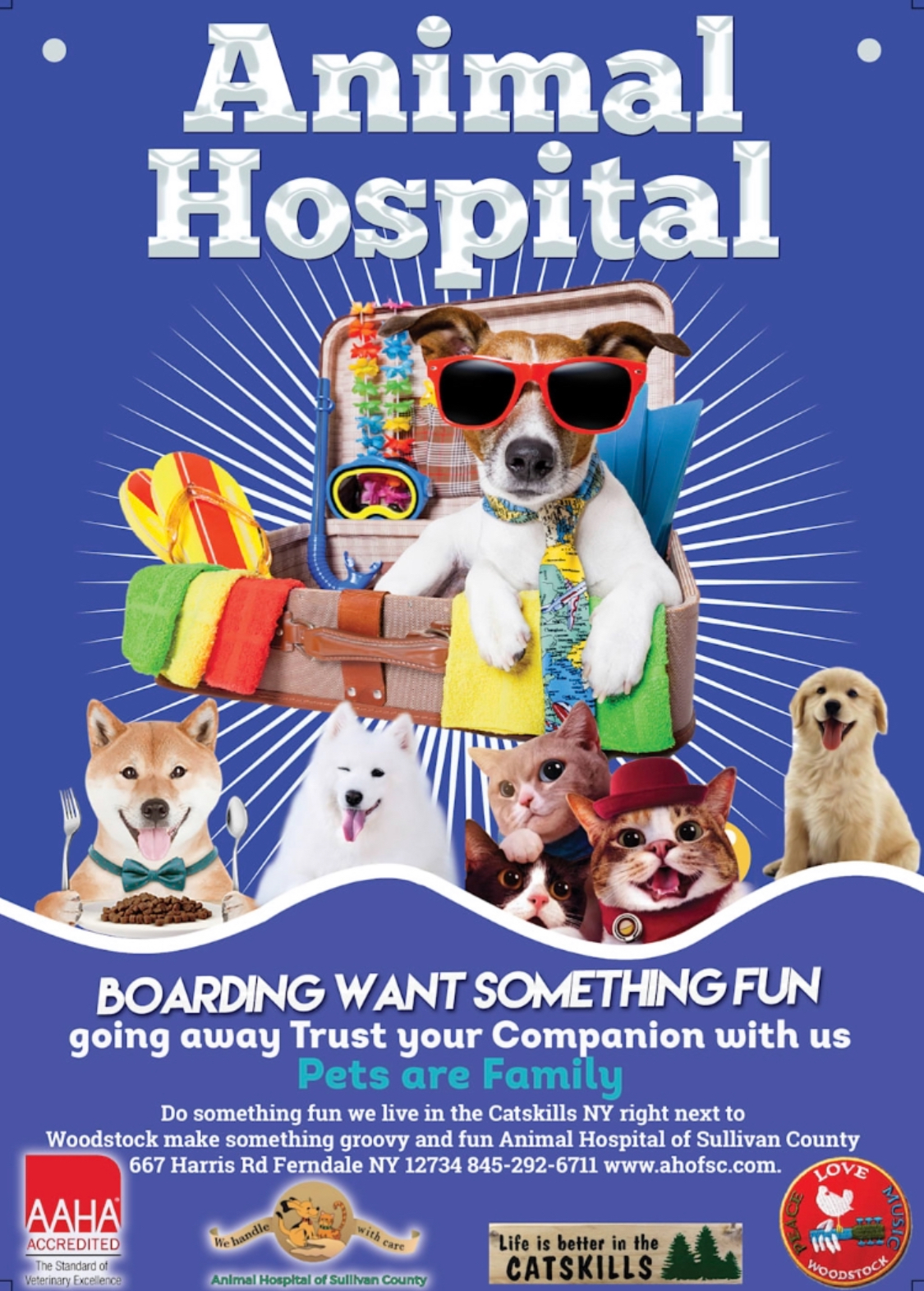
PET TRAVEL TIPS
It’s that time of year again. School’s out, the kids need to be driven seemingly all over the planet, and your spouse is eagerly suggesting, “We need to get away from it all.”
But sometimes, ‘getting away from it all’ means traveling with our furry friends. And as with everything in life, this involves trade-offs. Here are a few things to consider before flying off with Fido.
To begin with, does your pet-buddy get sick from travel? That can be a big issue. But your veterinary professional can help with that…just be in touch.
Next, how are you getting to where you’re going? Train? Plane? Automobile? (See what I did there?) Each of these travel methods comes with its own set of…well, challenges.
For example, in the car, you’ll want to consider exactly how you’ll secure Freckles in the vehicle. This will mean utilizing some sort of safety harness or pet car seat. And, of course, you’ll want to bring food, water, snacks, and any medication she may be taking. Bring a crate and things from home that are loaded with familiar smells—blankets, T-shirts, and maybe her bed from home. Oh, and don’t forget a leash!
If you’re crossing state lines, you might need to bring along Fluffy’s health certificates. And remember—not all hotels, Airbnbs, or rental apartments are pet-friendly, so it’s always good to do some advance planning.
On the safety end of things, it won’t hurt to know where pet clinics might be along your route. Also, maybe bring a pet first-aid kit along with you (your veterinary professional can help you choose what items to keep in it). Make sure Junior is tagged and/or chipped, and have photographs to show on the off-chance he gets lost.
Finally, it’s not a good idea to make a long trek Ozzy’s first experience in an automobile. If he hasn’t done much travel prior to the big excursion, hours upon hours in the car will be an anxious, uncomfortable experience for him. Get him used to the idea with shorter trips leading up to Departure Day. And tire him out with exercise before he’s strapped in for the ride.
Traveling by plane? Many of the same circumstances of auto travel apply. In addition, most airlines want you to submit a health certificate within 10 days of your flight. (Traveling to certain places requires a current rabies certificate as well, so you might need one of those, too.) As such, scheduling a visit with your veterinary professional is likely in the cards.
You should also keep in mind that various airlines have varied policies regarding transporting Fluffy, so remember to do your homework—just because Fly-By-Night Air might allow you to keep her on your lap in flight doesn’t mean that One-Wing Commuter will permit you to do the same.
The type of doggie you pal around with is also an issue to be looked into. Some carriers won’t allow you to bring along certain breeds. (This can apply to cats, too.) Do a little digging ahead of time into these policies to avoid a very unpleasant surprise at check-in. And don’t forget that there are always extra fees when pets travel, which are generally collected one-way. This means if Ozzy costs you $125 to get to Seattle, he’ll cost you $125 more to get back to New York.
That said, due to space concerns, purchasing tickets well ahead of time is highly recommended. And given that flying is already stressful for your four-legged friend, you’ll want to make his pet carrier as comfortable as is possible. According to the American Kennel Club—and I concur—the carrier, “should be big enough for the animal to stand, turn and lie down; there should be ventilation on opposing sides; and it should have a water bottle and a leakproof bottom covered with absorbent material. Affix a Live Animal label with arrows pointing to the upright position and include your name, address and phone numbers. Some carriers have wheels to help you roll them through the airport.” And just like when traveling by car, be sure to add items from home with familiar smells…at least, those of which the TSA will approve.
Going by train? Many of the same circumstances of air travel come into play. But there are some advantages:
- Train cars are usually bigger than airline cabins.
- A train schedule generally includes regular stops. A perfect way to fit in potty time!
- Train rides are generally smoother than are airline flights.
As always, you’ll want to check with your carrier for other terms and conditions.
Does all of this sound like too much work? Boarding your FBF (furry best friend) is always an option. We provide excellent boarding services here at reasonable rates, and you can be sure that Jolly will be well-cared for. Give us a call for information: 1-(845)-292-6711.
But if you’re still determined that “getting away from it all” includes your hirsute companion, I hope the above tips help everyone to have a great time.
* * *
As I write this, July 4 is imminent!
Our blog last year at this time—entitled “Fireworks, Pets, and Vets”—dealt with things you can do to make Fourth of July fireworks more tolerable for both the military veterans and the pets in your life. It would make for good reading now, but if you’re pressed for time, here are a few highlights:
- Most of our animal companions don’t like the sounds that fireworks make when they go off. Because their hearing is so sensitive, the various booms, hisses, and rat-a-tat-tats associated with fireworks can cause our pets heightened anxiety, which can result in behaviors that are harmful.
- Dogs will benefit from being put in a safe, quiet space that’s already familiar to them. It’s best to close windows and draw the curtains. Playing some music—or the TV—in the space can help reduce the impact of the bombs bursting in air outside. In some instances, medication can be used to calm your doggie down—just make sure to consult your veterinary professional before doing that.
- Cats who are afraid of fireworks will generally find a spot to hide in. Let them.
- Regarding military veterans, particularly those who served in combat…My husband and I are both veterans, and we can tell you that most of the veterans we know just don’t like fireworks. Certainly, we’re very proud of our country and are respectful when attending formal ceremonies…ceremonies where we know fireworks are being featured, so we can prepare for that. But those random fireworks that seem to occur in the middle of the night—without warning—days before and after July 4? No, we’re not really good with that.
With these things in mind, everyone please have a safe and joyous Fourth of July in 2024!
Dr Barbara J Bodolosky DVM
667 Harris Rd
Ferndale NY 12734


